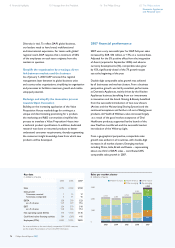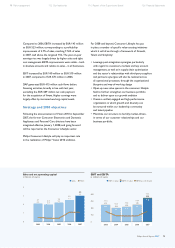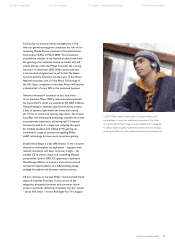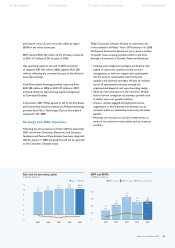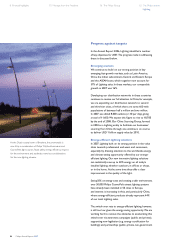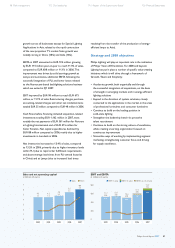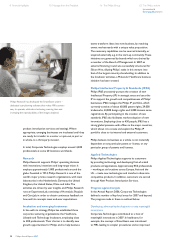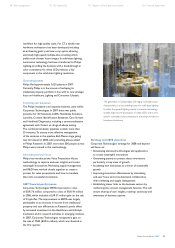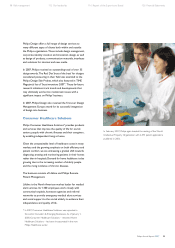Philips 2007 Annual Report Download - page 77
Download and view the complete annual report
Please find page 77 of the 2007 Philips annual report below. You can navigate through the pages in the report by either clicking on the pages listed below, or by using the keyword search tool below to find specific information within the annual report.
Philips Annual Report 2007 83
Solid-state or LED lighting represents the most signicant
development in lighting since the discovery of electric
light well over a century ago. Offering unprecedented
design freedom in terms of color, dynamics, miniaturization,
architectural integration and energy efciency, it is opening
up exciting new possibilities, e.g. for ambience creation.
Our customers are mainly in the professional market.
The Lamps business operates its sales and marketing
activities through the professional, OEM and consumer
channels, the latter also being used by our consumer
luminaires business. Professional Luminaires is organized
in a Trade business (commodity products) and a Projects
business (project luminaires); for the latter, the main focus
is on lighting designers, architects and urban planners.
Automotive Lighting is organized in two businesses: OEM
and After-market. Special Lighting and solid-state lighting
components and modules are OEM businesses, while
Lighting Electronics’ sales and marketing are conducted
through both the OEM and wholesale channels.
The division has manufacturing facilities in 25 countries,
and sales organizations in more than 60. Commercial
activities in other countries are handled via dealers working
with the International Sales organization. Lighting has some
54,000 employees worldwide.
Lighting complies with all relevant regulatory requirements,
most notably the EU WEEE (Waste from Electrical and
Electronic Equipment) Directive and the RoHS (Restriction
of Hazardous Substances) Directive.
With regard to sourcing, please refer also to the business
description of Philips Supply Management that begins on
page 96 of this Annual Report.
Philips Lighting is the global market leader, with recognized
expertise in the development, manufacturing and application
of innovative lighting solutions. Philips pioneered many of
the key breakthroughs in lighting technology, creating a solid
basis for both its present activities and future aspirations.
Through its expertise and in-depth understanding of
the
customer and the end-user, the division is a market-
driven
innovator in lighting and a shaper of the lighting
industry
landscape. As stated in its mission, Philips
Lighting understands
people and improves their lives
with lighting.
Lighting’s products are found throughout the home
and in professional applications – at work, on the move,
in shops, in the city, hospitals, sports stadiums, etc.
The division consists of the following businesses:
Lamps – incandescent; halogen; (compact) uorescent; •
high-intensity discharge
Consumer Luminaires – functional; decorative; lifestyle•
Professional Luminaires – city beautication; road •
lighting; sports lighting; ofce lighting; shop/hospitality
lighting; industry lighting
Lighting Electronics – electronic gear; electromagnetic •
gear; controls
Automotive and Special Lighting Applications – •
car headlights; car signaling; other transport vehicles;
optical lighting; infrared; ultraviolet; projection
Solid-State Lighting Components and Modules – •
retrots; modules; ashlight; display; LUXEON.
Two key trends are shaping the global lighting market:
the need for energy efciency and the emergence
of solid-state lighting.
Lighting presents a clear opportunity to save energy
and slow climate change. It accounts for some 19%
of global electricity consumption. Innovative lighting
solutions can realistically save up to 40% energy on
today’s installed base, while also improving the quality
of the light.
98 Risk management 112 Our leadership 116 Report of the Supervisory Board 126 Financial Statements
“ We are building a strong position through the complete
solid-state lighting value chain for future growth in energy-
efcient lighting solutions using LED sources.”



